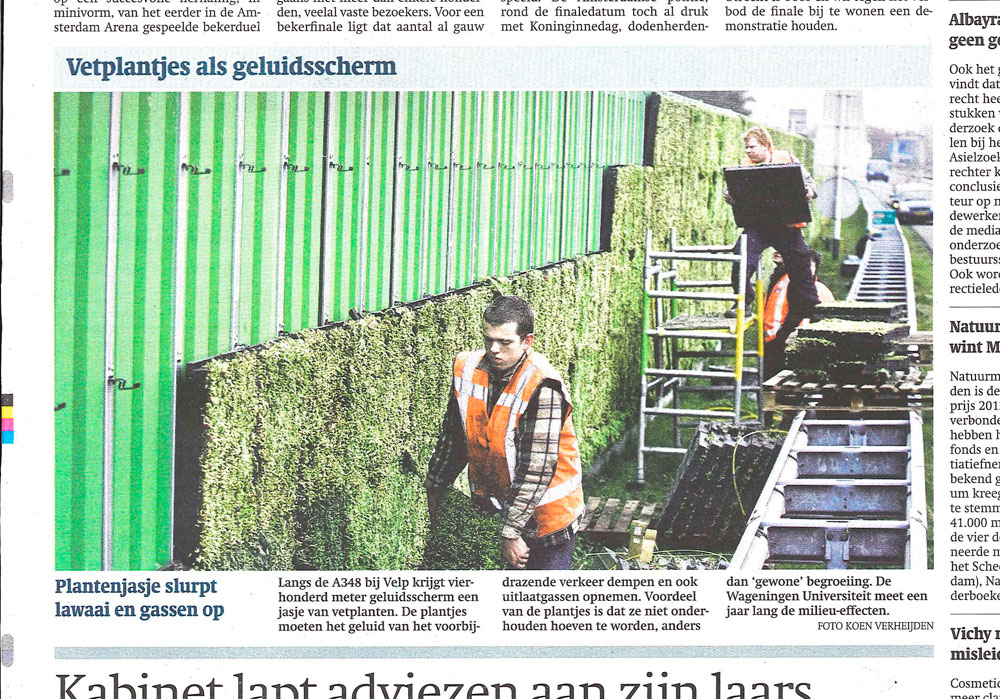A road traffic noise reduction barrier along the A348 will get a coat of succulent plants, which should absorb particulate matter and reduce noise.
Car drivers near Velp will soon have a radically new view. No longer will they drive past boring noise reduction barriers; instead, they’ll see a green wall consisting of succulent plants. This will be a testing site some 400 meters long, commissioned by the Province of Gelderland in collaboration with knowledge institute Alterra and the University of Wageningen. The experiment must reveal how much noise is reduced by the plants and how much particulate matter they’ll absorb.
“It’s an excellent idea. Traffic noise reduction barriers have a promising potential for reducing pollution,” says postdoc researcher, Dr Marc Ottelé (Civil Engineering), who published his PhD research last year on vertical greenery. “The potential of the plants is promising, and we know that they intercept particulates. However, it’s very difficult to say how much particulates the plants intercept exactly. It’s very complex to measure this.”
Bob Ursem, scientific director of TU Delft’s Botanical Garden, agrees with Ottelé: “I estimate that about 5 to 7 per cent of the particulates will be reduced because of plants, but this depends on the characteristics of the wall and on the direction of the wind. Planting green against the wall is a passive system. Better results could be obtained with active systems. One could think of technology that absorbs the particulates.”
Ursem has invented such a particulate catcher. “In an open environment, 60 per cent of the particulates could be absorbed”, he states. For the new A348 barrier, succulent plants will be used because they do not need much water. “Therefore it’s a good choice”, says Ottelé. “The succulent plants are also very lightweight, which makes it easy to attach them to a wall. And they’re cheap.”
The green wall should also reduce noise. “I think it would only muffle the sound a little bit,” says Ursem. He wrote a chapter on how to effectively muffle sound in a book entitled ‘Ecological Engineering’. “Bushes or hedges planted close to each other would work better. They have a denser structure than the succulent plants.” Ottelé however is more positive about the sound reduction because of the substrate layer that is used. “This will absorb the sound better than the standard hard surfaces.”
On Monday the Dutch TV program, Pownews, vehemently criticised the green wall, saying that it is ridiculous that 200,000 euros was spent on it. Ursem strongly disagrees: “The effect of the plants may not be spectacular, but every little helps. They absorb particulates and reduce the noise a bit. And it also makes the highway look better. Visually it’s a good improvement.”
Ursem and Ottelé do not think that 200,000 euros has been badly spent during the financial crisis. “For this kind of structure, it’s actually quite cheap,” Ottelé days. “Normally, one would pay a lot more for a green wall of 400 meters.”
Ottelé believes that in the near future more green walls will arise next to highways. “Along the A13 between Rotterdam and Delft, there’s also a recently placed green noise reduction barrier. Common ivy grows against the wall. Houses could also very well use green walls. Plants influence thermal behaviour by insulating properties and reducing pollution. They’re cheap and have great potential.”
Een beetje wiebelig stonden sommige deelnemers aan de workshop Tai Chi dinsdagmiddag in het Mekelpark. Studium Generale viert deze week in een tent bij de aula haar 65-jarig bestaan met een uitgebreid programma aan lezingen, workshops, debatten en feestjes.



Comments are closed.